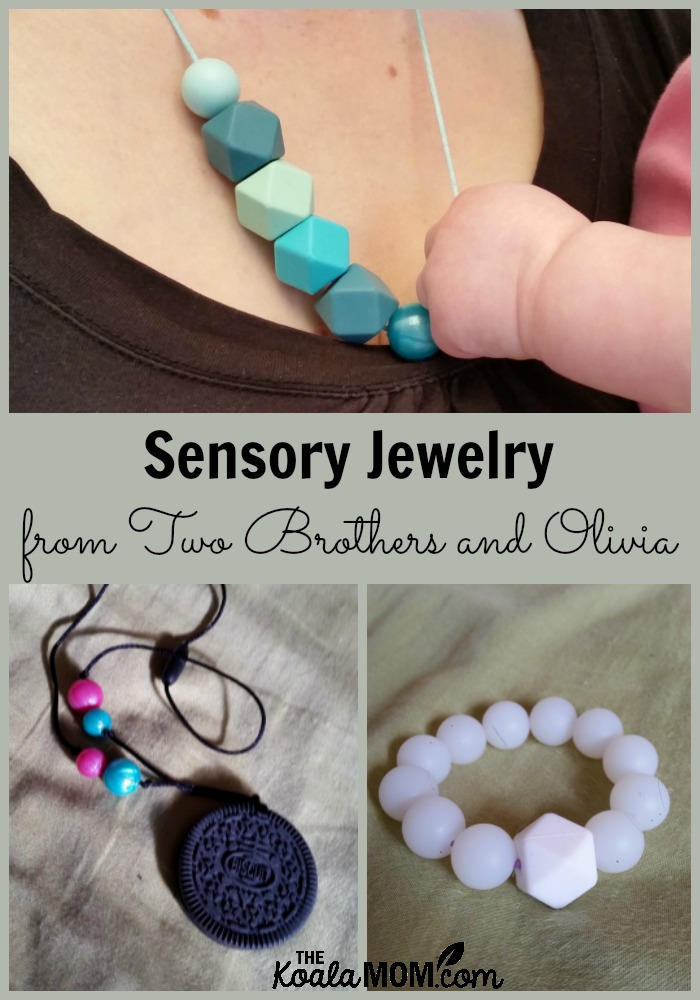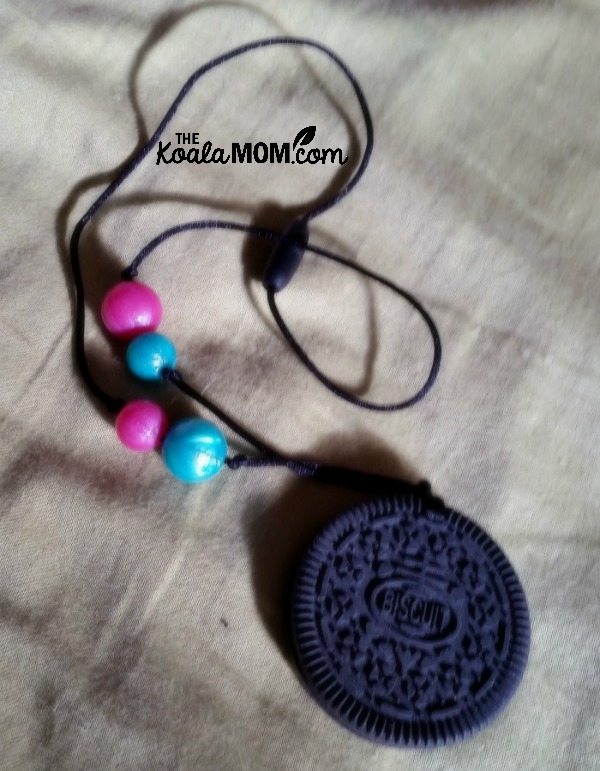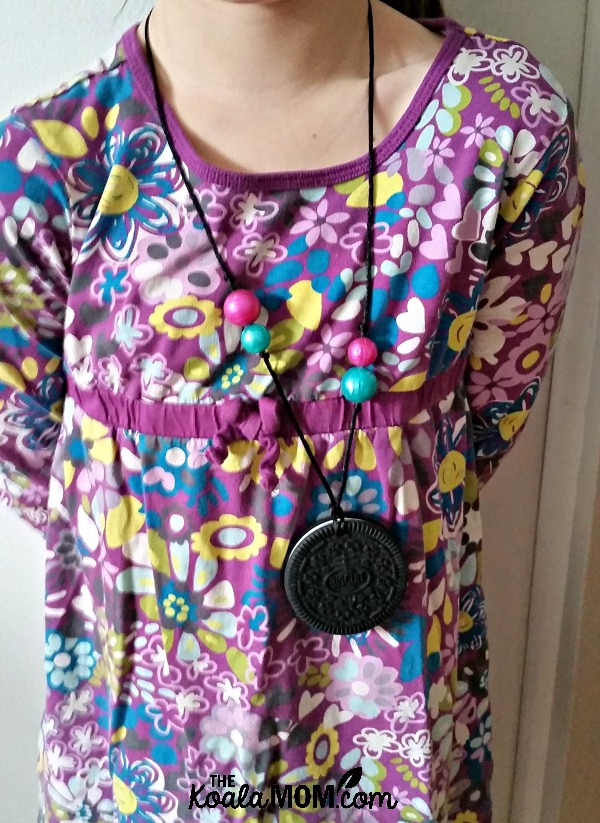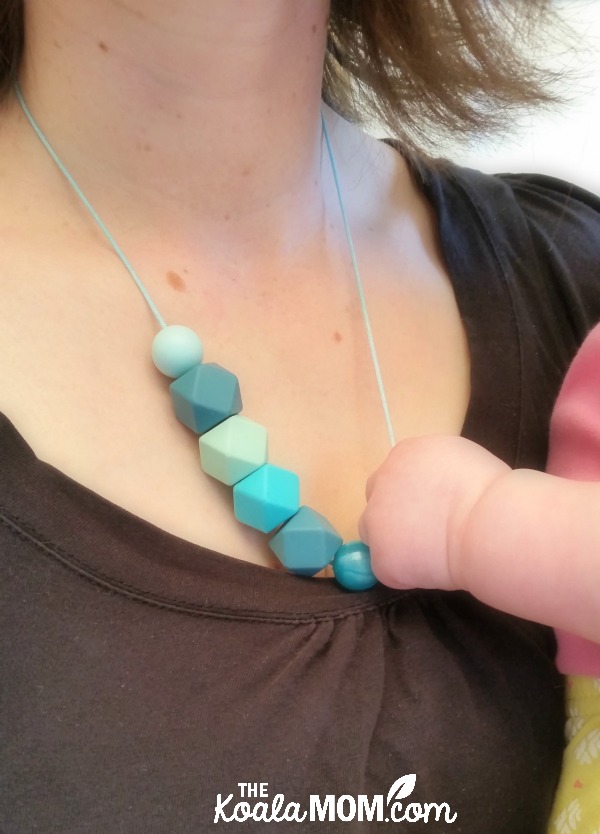It took me a while to notice that Lily was chewing her hair. The first few times she did it, I didn’t really pay attention. Then one day I said, “Lily, stop chewing your hair” and thought, “She’s been doing this a lot lately.” It didn’t seem like a huge problem, just something she did when she was concentrating hard (the way I hold my tongue between my lips) but it also didn’t seem like a good idea.
I thought about cutting her hair, because she also wasn’t brushing it well and wouldn’t let me brush it. Short hair would solve both the chewing and the tangles, but Lily wouldn’t have that. Then I found out about sensory jewelry for children who are habitual biters.
This post contains affiliate links; as an Amazon associate, I earn from qualifying purchases.
Sensory Jewelry for Kids Who Chew
Something clicked that made me think about Lily’s hair chewing in a new way. There is, of course, a wealth of information on the internet and social media about sensory processing disorders. While I don’t think Lily has that, I do think that we all develop habits that help us process what’s going on around us. For example, I know I chew the inside of my lip or roll my ring around my finger.
I showed Lily the necklaces and invited her to pick one. She liked the cookie necklace. When it arrived, she made a big deal out of biting it (and growling). Then she put it on her bed and forgot about it for a bit.
Now that the novelty is over, we’re working on making better habits. Instead of telling her not to chew on her hair, I could tell her to chew on her cookie. Telling someone not to think about or do something makes it more likely that they’ll do it; simply redirecting the energy seems more effective. She doesn’t always bite it; sometimes she just plays with it or rolls the beads around her fingers.
Sensory Bracelets for Bedtime
You can also get sensory jewelry for other purposes. A glow-in-the-dark bracelet can help empower kids and prevent nighttime fears of darkness. I gave that to Jade. I can’t remember if Sunshine and Lily went through a phase of being scared of the dark, but Jade needs us to leave the hall light on and the door open until she falls asleep.
I explained that the bracelet would glow in the dark for her and she could hold it while she’s falling asleep. So far, it’s been working great. She and Lily share a room, and now I tuck them in, make sure Jade has her bracelet, give them each a kiss and an “I love you” and close the door. She’s usually asleep within minutes and is less worried about the dark.
Teething Necklaces for Mom & Baby
Pearl and I got a teething necklace. I’ve actually wanted one for quite a while, because I’ve seen other moms wearing them (and a few babies chewing on them) and thought they looked pretty. It was tough picking just one necklace for myself because there are so many pretty designs. I finally settled on a teal necklace (one of my favourite colours).
Pearl is just now starting to chew on everything, so its handy to have something for her to chew on that also looks good on me. I can also wear this necklace without worrying about her grabbing it and breaking it (in the past, I’ve just given up wearing necklaces for a year or more until the babies pass that stage). Today’s post is brought to you by this necklace, which kept Pearl busy for a while while I typed. 🙂
Why Sensory Jewelry?
Martina is a local Vancouver mom who made these sensory jewelry pieces but has now closed her business. She shared that the inspiration for the sensory jewelry came from her own three kids:
“So far, two have had issues with chewing. I was going crazy! They were putting holes in their clothes, their fingernails looked awful, yes I did cut my daughter’s hair and I even went to a pediatrician’s office but all she recommended was a stress ball. A stress ball seemed so impractical, especially at a playground. I knew the solution required was something that’s always close to them, and something familiar too, and voila! the cookie necklace was born. It’s made from 100% food grade silicone. Even the pediatrician was impressed! Chewing or biting into it releases their anxiety; it’s comforting and it’s something they can carry with them whenever they go.”
She adds, “It works in a way that it gives them something else to chew on—something that’s safe, that they already recognize and like. It does take a few tries and reminders and they have to wear the sensory jewelry until their habit grows out. My daughter took few months to completely break the habit, and my middle son is still in the habit, but wears his necklace daily and even asks to wear it. My youngest, the baby, I’m hoping won’t become a chewer.”
Do you know anyone with a sensory processing disorder? Have you noticed that your children have biting or chewing habits like Lily?






3 Comments
I absolutely love the idea of this jewelry! That is a great idea for mixing function and fashion. One of my daughters have trouble biting her nails, so I will have to get her one of these.
My girls both chew lots and seem to have some sensory needs like chewing and fidgeting. Love this jewelry!!!
Isn’t it pretty? My oldest wanted some of the jewelry too, even though she doesn’t fidget as much as my second. 🙂